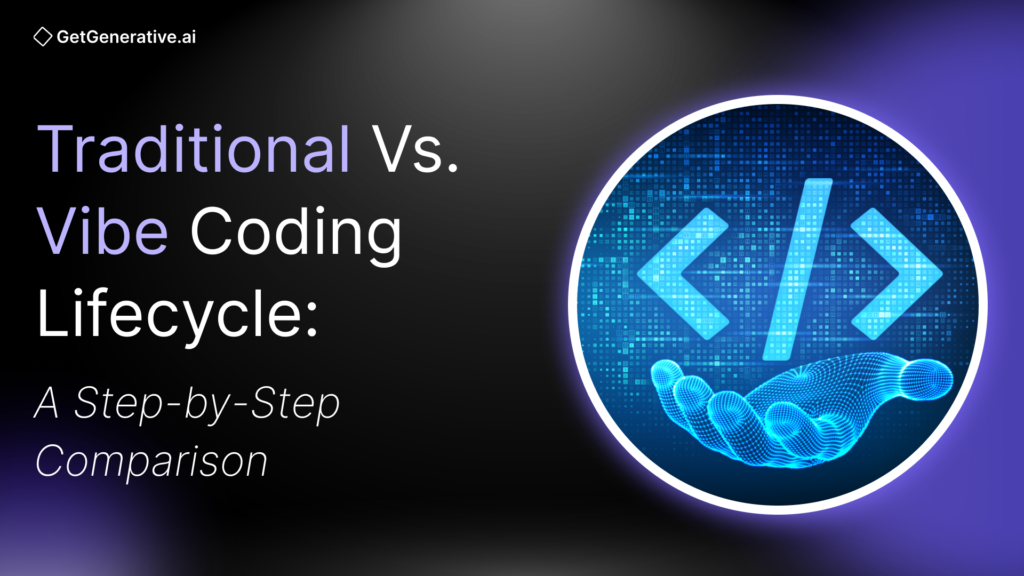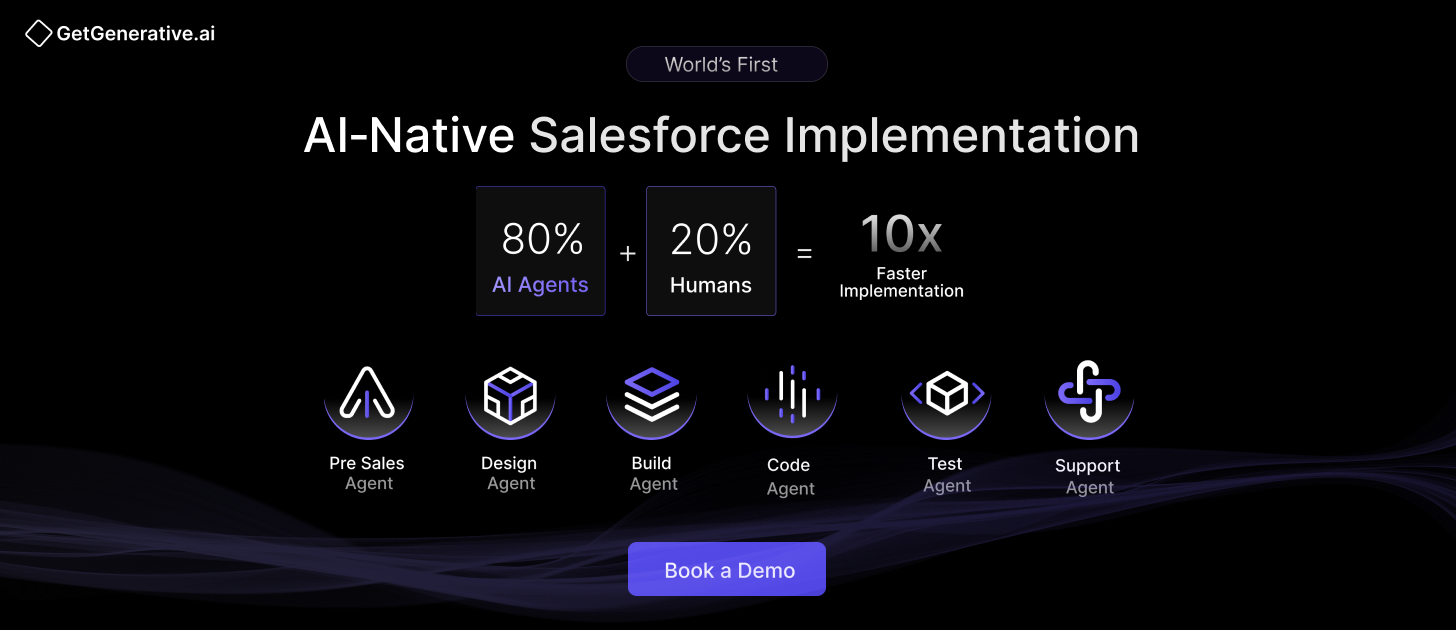Traditional vs. Vibe Coding Lifecycle: A Step-by-Step Comparison
A viral post recently summed up this movement: “You don’t need to code; just vibe code it.”
This sentiment is not just hype—industry adoption of AI-assisted development is surging. According to the 2023 Stack Overflow Developer Survey, over 70% of developers are already using or plan to use AI coding tools, a trend that’s accelerating as tools like GitHub Copilot, Cursor, and Replit gain traction.
This blog provides a deep, step-by-step comparison of the Traditional Software Development Lifecycle (SDLC) and the emerging Vibe Coding Lifecycle. We’ll analyze how each model handles key phases—planning, architecture, coding, QA, deployment, and maintenance—with real-world examples, performance benchmarks, and strategic takeaways for decision-makers.
The goal is to help technology leaders understand how to adopt vibe coding without sacrificing quality or control.
Step 1: Requirements Gathering and Planning
Traditional Approach
In traditional SDLC, planning is formal, documentation-heavy, and often time-consuming. Requirements are gathered through stakeholder interviews, workshops, and detailed documentation such as user stories, epics, and acceptance criteria. The project is then divided into structured phases, such as sprint planning in Agile or milestone reviews in Waterfall.
The benefit of this approach is predictability—clear timelines, budgets, and stakeholder alignment. It reduces risk by minimizing ambiguity early. However, the downside is slower initial momentum, particularly in fast-moving environments where agility is crucial.
Vibe Coding Approach
In contrast, vibe coding starts with a prompt, not a plan. Developers (or even non-developers) describe the desired functionality in natural language. For example:
“Build a secure login system with 2FA and password reset.”
The AI assistant translates this into working code almost instantly. IBM’s AI Engineering team highlights that clear, goal-oriented prompts are the new specs in vibe coding.
The approach is iterative—users refine their prompts based on real-time output, making the process highly interactive. It shortens ideation cycles dramatically, enabling teams to test and pivot on the fly.
Step 2: System Design and Architecture
Traditional Approach
After planning, the next phase is system design. Architects define the overall structure, select the tech stack, and plan how components interact. Outputs include UML diagrams, API blueprints, and data models.
This method supports large-scale systems by emphasizing scalability, maintainability, and security. It’s particularly effective for compliance-heavy industries such as finance, healthcare, and defense. However, this step is often time-intensive and assumes static requirements, not ideal for rapidly evolving products.
Vibe Coding Approach
Vibe coding skips traditional architecture upfront. Instead, developers start with a prototype prompt and let the architecture emerge.
For example:
“Create a web app with user registration and a dashboard.”
The AI generates a scaffold—routes, frontend forms, basic database schema—without a formal design. As needs evolve, developers prompt the AI to adapt the design incrementally.
This “refactor as you go” mindset supports rapid MVP creation but risks architectural inconsistencies if not later reviewed. Teams often address this by layering traditional design reviews after initial code is generated.
Step 3: Development and Coding
Traditional Approach
In traditional workflows, development is manual. Engineers write every line, often referencing documentation and working within structured repositories. They rely on strict version control, code review cycles, and debugging tools.
The process is thorough but slow. A typical feature can take days or weeks. However, it ensures full code ownership and deep understanding—ideal for long-term maintenance and mission-critical apps.
Vibe Coding Approach
In vibe coding, developers interact with the AI as if it were a coding partner:
Developer: “Create a function to handle user login via Google OAuth.”
AI: Returns full implementation with validation, redirects, and logging.
Developers review and revise, but much of the heavy lifting is done automatically. According to GitHub’s Copilot study, AI-assisted developers completed tasks up to 55% faster.
This model democratizes development—junior engineers or even non-technical team members can create prototypes with ease. The trade-off is reduced code comprehension, as AI-generated blocks can become “black boxes.”
Also Read – Vibe Coding in Salesforce: What It Is and Why It’s the Future
Step 4: Testing and Quality Assurance
Traditional Approach
Testing in traditional SDLC includes unit, integration, performance, and security testing. QA teams often use test-driven development (TDD) and enforce peer code reviews. Static analyzers and linters ensure compliance with coding standards.
The philosophy is “trust but verify”, which makes it reliable for enterprise-grade apps but adds significant time overhead.
Vibe Coding Approach
AI tools now generate both production and test code. A developer can prompt:
“Generate unit tests for this function.”
And receive a full suite of test cases, including edge scenarios.
Tools like Zencoder’s Unit Test Agent and platforms like Cursor AI allow automated bug-fixing based on test failures. However, AI-generated tests often miss corner cases, and security testing remains weak.
According to a study from the Cloud Security Alliance, 36% of LLM-generated code had at least one security flaw. Organizations that skip human QA processes face deployment risks.
Step 5: Deployment and Release
Traditional Approach
In conventional SDLC, deployment is a structured, multi-step process often handled by DevOps teams. This includes:
- Building artifacts
- Configuring environments
- Managing containerization (e.g., Docker)
- Running automated tests via CI/CD
- Scheduling releases, with rollback plans in place
Organizations often employ manual approvals and change management, especially in regulated industries. The primary goal is stability—every deployment is tested, staged, and monitored before going live.
Vibe Coding Approach
In the vibe coding model, deployment is fast, AI-assisted, and sometimes just one click. Tools like Replit, Windsurf, and GitHub Codespaces support workflows where you describe the app, generate the code, and hit “Deploy.”
Example:
“Build and deploy a Next.js blog site with Firebase backend.”
The AI generates the app, prepares Docker files or deployment scripts, and publishes it—sometimes using Netlify, Vercel, or custom cloud setups.
This is ideal for small-scale or greenfield apps, but enterprise deployment still requires human oversight. CI/CD integration, performance monitoring, compliance checks, and rollback strategies remain essential.
Key concern: automated deployment without robust QA can propagate AI-generated bugs directly into production. Organizations must enforce quality gates in AI-assisted DevOps pipelines.
Step 6: Maintenance and Iteration
Traditional Approach
After deployment, traditional software enters the longest phase of its lifecycle—maintenance. This involves:
- Fixing bugs
- Refactoring code
- Updating dependencies
- Enhancing features
Teams track issues via tools like Jira or ServiceNow, follow coding standards, and manage technical debt over time. Because developers wrote the code themselves, they understand its structure and can maintain it efficiently.
Vibe Coding Approach
In vibe coding, maintenance becomes a prompt-driven exercise. Developers can say:
“Update this function to include pagination,”
and the AI will modify the code.
This works well if the original code is readable and the developer remembers the original prompts. However, challenges include:
- AI-generated code may lack documentation or rationale
- Developers inheriting AI code may struggle to debug it
- Inconsistencies can arise when different team members prompt the AI differently
Over time, technical debt can compound if AI code isn’t cleaned up. Without structured review and refactoring, codebases risk becoming disjointed.
That said, AI can assist with:
- Auto-refactoring (“Make this code more readable”)
- Auto-documentation (“Explain what this function does”)
- Dependency upgrades (“Update this project to React 19”)
Also Read – A Comprehensive Guide to Vibe Coding Tools
How to Harness the Power of Vibe Coding
Vibe coding is not a replacement for traditional methods—it’s an accelerator. The most effective organizations combine both to achieve speed, creativity, and reliability. Here’s how:
1. Use Vibe Coding for Rapid Prototyping
Startups and product teams can reduce time-to-demo by building MVPs in hours instead of weeks. Use AI to quickly generate UI components, test data, and REST APIs for experimentation.
2. Apply Traditional Rigor to Critical Components
Security, performance-critical code, and domain-specific logic should follow formal coding practices. Let AI draft boilerplate, but rely on senior engineers for core modules.
3. Implement AI Code Review Policies
All AI-generated code should be reviewed, preferably with stricter guidelines than manual code. Add version tags like // generated by AI and enforce static analysis tools to catch silent failures.
4. Train Your Team in Prompt Engineering
Prompt engineering is a new skill. Developers should learn how to craft clear, outcome-specific prompts and validate AI responses. Host workshops and integrate this into onboarding.
5. Strengthen QA with AI-Aware Testing
Ensure every AI-generated module has tests, both AI-generated and human-authored. Expand security testing and adopt tools like BaxBench to analyze AI-generated code vulnerabilities.
6. Govern AI Usage in CI/CD Pipelines
Use policy-based deployment systems to block unsafe changes. Require AI to pass quality gates: code coverage, static analysis, and senior approval. Maintain logs of AI interactions for auditing.
Final Thoughts
The rise of vibe coding marks a turning point in how software is built. It allows anyone—from junior devs to domain experts—to bring ideas to life quickly through natural language. It democratizes development, accelerates timelines, and unlocks creativity.
At GetGenerative.ai, our proprietary AI-driven Agents streamline every phase of your Salesforce implementation, while elite global experts ensure strategic oversight, precision, and quality.
AI-powered. Expert-guided. 10x faster delivery.
👉 Discover our AI Salesforce Consulting Services




